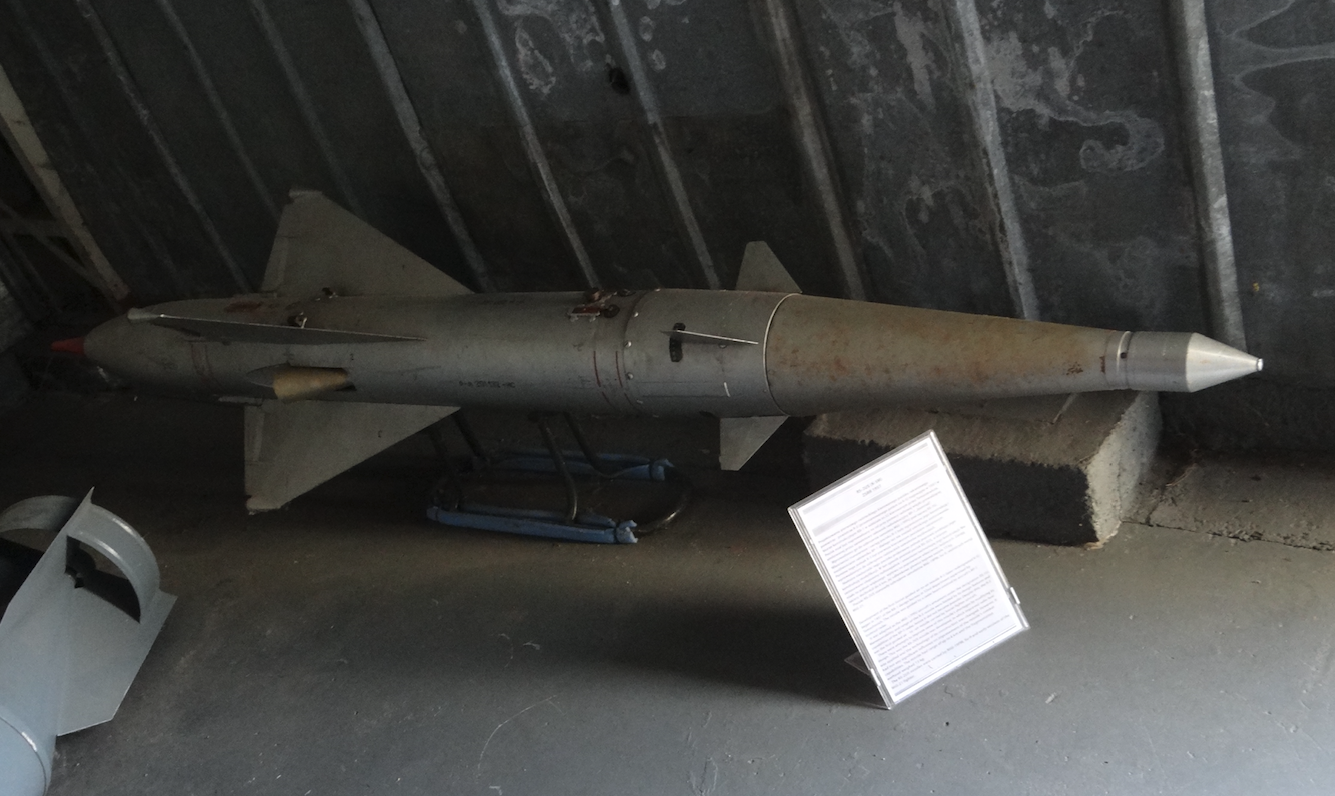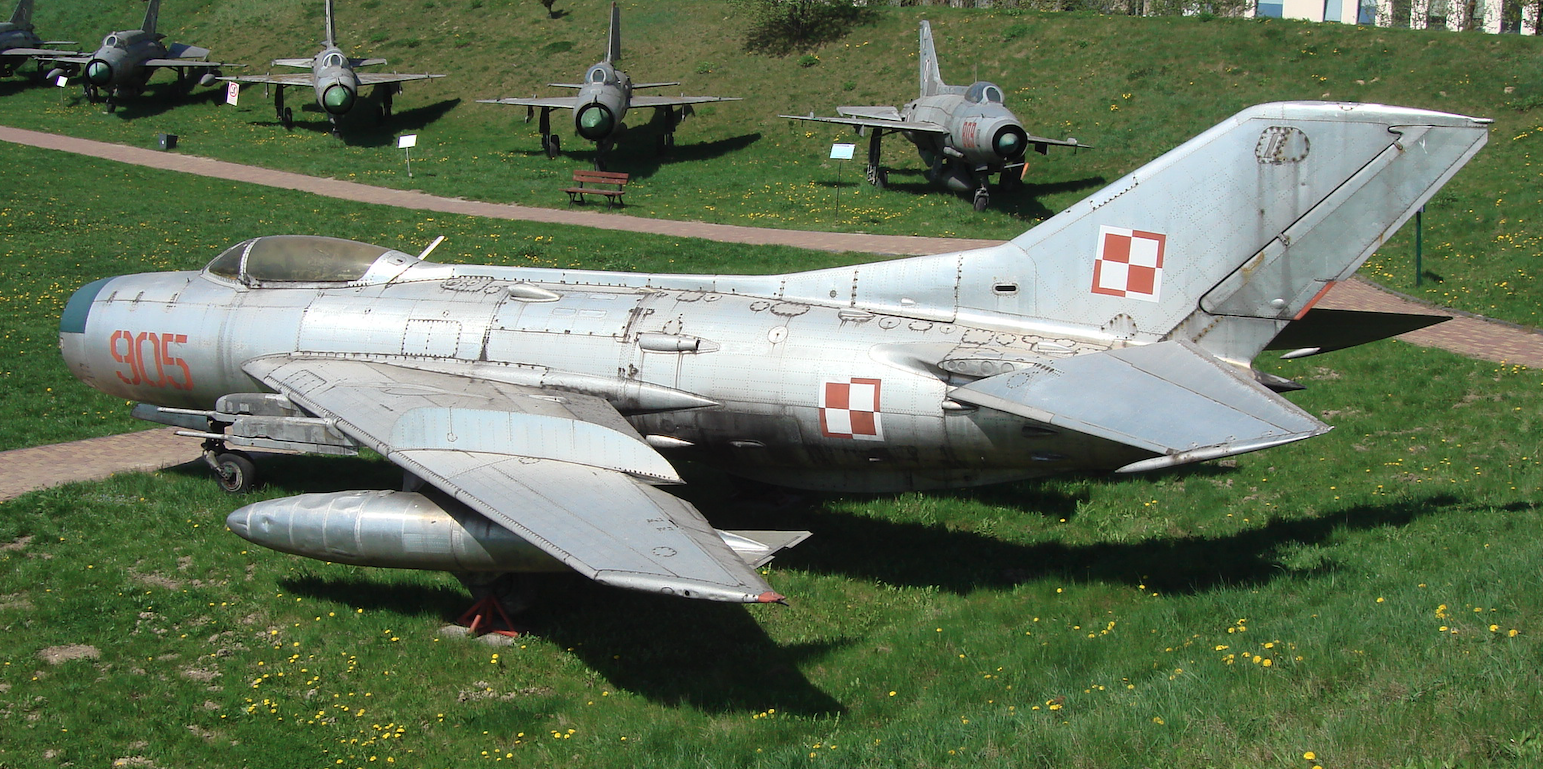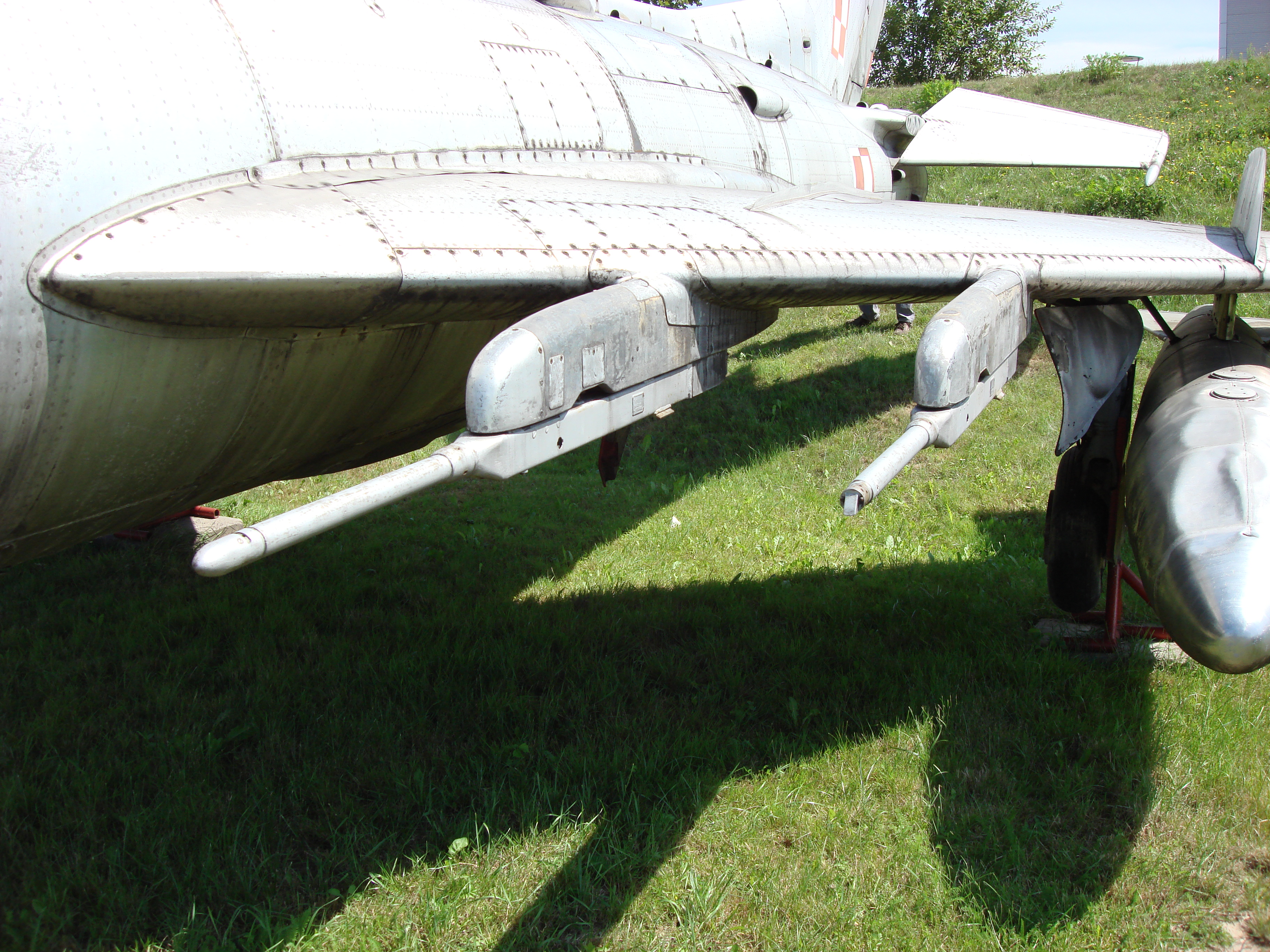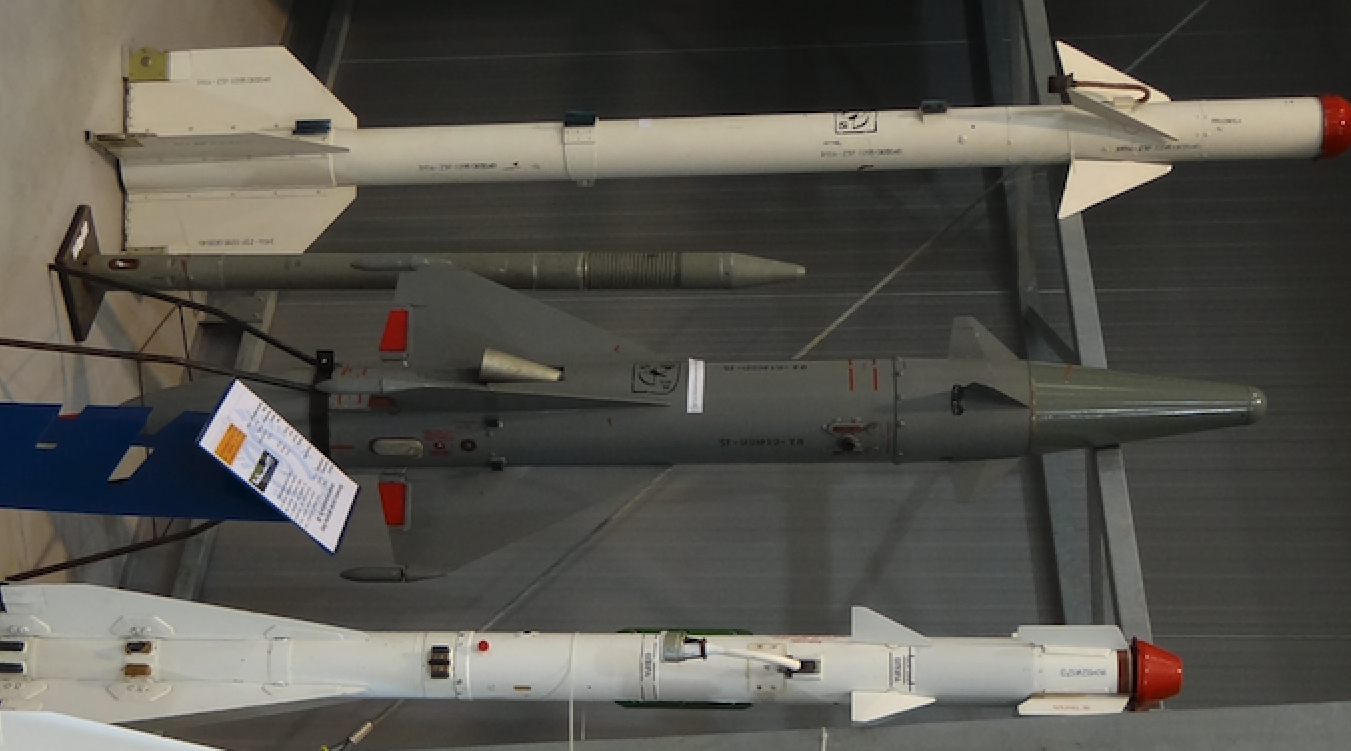Kraków 2020-10-10
Pocisk rakietowy kierowany klasy powietrze-powietrze RS-2 (K-5).
W dniu 16-04-1949 roku, firma Lockheed zbudowała i wykonała pierwszy lot samolotu YF-94, który jako Lockheed F-94 A Starfire wszedł na uzbrojenie USAF. Kilka miesięcy później wprowadzono do uzbrojenia wersję Lockheed F-94 C Starfire, który jako uzbrojenie miał wyłącznie pociski rakietowe klasy powietrze-powietrze. Samolot miał 48 pocisków rakietowych kalibru 70 mm. 24 pociski zostały umieszczone w przedniej części kadłuba, a pozostałe w zasobnikach na końcach skrzydeł. Rakietyzacja pola walki postępowała szybko.
Od 1947 roku, w USA podjęto prace nad pociskiem rakietowym wykorzystującym półaktywny system kierowania radiolokacyjnego. Po angielsku zwany Beam Riding, czyli jazda po wiązce. Lot pocisku po wiązce opiera się na sygnale skierowanym w kierunku celu z radaru samolotu atakującego. Sygnał trafia do odbiornika w pocisku, który na podstawie analizy tego sygnału skierowuje się na cel. Sygnał nie musi być silny, ponieważ nie jest konieczne używanie go również do śledzenia celu. Głównym zastosowaniem tego rodzaju systemu jest niszczenie samolotów lub czołgów. Jak działa taki system? Po pierwsze, stacja celownicza kieruje wąską wiązkę radarową na samolot wroga. Następnie pocisk zostaje wystrzelony i w pewnym momencie po wystrzeleniu pocisk zostaje „zabrany” przez wiązkę radaru. Od tego etapu pocisk próbuje utrzymać się wewnątrz wiązki, podczas gdy stacja celownicza utrzymuje wiązkę skierowaną na cel. Pocisk sterowany przez znajdujący się w nim komputer kieruje się do celu. Korzystając z tej zasady powstał pierwszy tego typu pocisk firmy Hughes Aircraft AIM-4 Falcon.
Pocisk rakietowy RS-1U (K-5).
W 1948 roku, w CCCP w biurze KB-1 powstał wydział konstrukcyjny kierowany przez inżyniera Dmitrija Ludwigowicza Tomaszewicza. Celem zespołu było prowadzenie prac nad pociskami kierowanymi, korzystający z zasady Beam Riding. W 1951 roku, utworzono komórkę pod kierunkiem inżyniera K. Patruchina, którego zadaniem było zbudowanie niewielkiego pocisku klasy powietrze-powietrze. Niektóre podzespoły nowego pocisku powstały w innych biurach konstrukcyjnych. Na przykład: silnik na paliwo stałe, głowica bojowa i zapalnik zbliżeniowy. Głównym zadaniem zespołu inżynierów było opracowanie układu kierowania pocisku rakietowego. W 1952 roku, w wyniku działania wywiadu CCCP, realizowane zadanie otrzymało lepsze finansowanie. Zespół inżynierów powiększono. Doprecyzowano także temat zadania – Zwalczanie bombowców przeciwnika w każdych warunkach pogodowych, z tylnej półsfery. Pierwotnie do roli nosiciela nowego pocisku wytypowano samoloty: MiG-15 P, MiG-17 P, Jak-25. Wszystkie te samoloty dysponowały radarami Izumrud. Ostatecznie wybrano samolot MiG-17 PF oraz MiG-19.
Pierwsze egzemplarze doświadczalne pocisku rakietowego ukończone zostały w grudniu 1952 roku. Wiosną 1953 roku, rozpoczęto pierwsze testy naziemne. Latem 1953 roku, wykonywano testy zrzucania z samolotu MiG-15, pocisku nie posiadającego napędu, a których zadaniem było testowanie układu naprowadzania.
W październiku 1953 roku, całość zadania przeniesiono do nowego biura OKB-2, kierowanego przez inżyniera Pawła Gruszyna. Wówczas to system rakietowy otrzymał oznaczenie zakładowe K-5. Zmian w pocisku było dużo. Wydłużono kadłub o 0,30 m, aby pomieścić poprawione wyposażenie. Zmodyfikowano układ sterowania. Testowym nosicielem pocisku był samolot MiG-17 (SP-6). Strzelano pociskami do samolotów-celi. Okazało się, że czas pracy silnika rakietowego pocisku jest za krótki i zasięg jest niewystarczający.
W marcu 1955 roku, przeprowadzono pełny test pocisku K-5. Celem był zdalnie kierowany bombowiec Tupoliew Tu-4. W trakcie kolejnych prób odpalono 71 pocisków K-5. System K-5 przyjęto na uzbrojenie CCCP w 1956 roku. Był to pierwszy wdrożony do służby pocisk kierowany klasy powietrze-powietrze w dziejach CCCP. Uruchomienie produkcji i eksploatacja systemu natrafiały na wiele trudności. Fabryka, która produkowała pociski K-5, nie miała doświadczenia z bronią rakietową. Łącznie zbudowano ponad 3 000 pocisków RS-1U, jednak setki pocisków nie ukończono.
System oznaczono S-1-U. Pociski K-5 w liczbie 4 egzemplarzy, na belkach APU-4, zamontowano na samolotach MiG-17 PFU. Samoloty MiG-17 PFU pozbawiono uzbrojenia strzeleckiego. Samolot ma radar RP-1U, współpracujący z pociskiem K-5.
Opis pocisku RS-1U (K-5).
Kadłub pocisku RS-1U ma kształt wrzeciona. Układ aerodynamiczny jest typu kaczka, czyli skrzydła w tyle, a usterzenie jest w przedzie. Usterzenie i skrzydła są w układzie krzyżowym. Skrzydła mają kąt natarcia 60 stopni, a krawędź spływu -12 stopni. Usterzenie także ma trójkątny obrys, kąt natarcia wynosi 45 stopni, a krawędź spływu -5 stopni. Na końcach skrzydeł są wytwornice dymu, które mają ułatwiać obserwację pilotowi odpalonego pocisku. Kadłub pocisku i powierzchnie aerodynamiczne wykonano ze stopów aluminium i magnezu.
Silnik rakietowy jest na paliwo stałe, które bazuje na prochu, ma ciąg 13,15 kN. Korpus silnika jest wykonany ze stali. Dwie dysze wylotowe silnika umieszczono z boku kadłuba i są odchylone pod kątem 15 stopni od osi. Kadłub pocisku, przed wpływem gorących gazów jest chroniony nakładkami z azbestu.
Kadłub pocisku RS-1U podzielony jest na pięć sekcji, z których pierwsze trzy mieszczą głowicę bojową o wymuszonej fragmentacji skorupy ładunku i masie 9,25 kg, zapalnik zbliżeniowy RW-1U (AR-43), z pierścieniowym czujnikiem umieszczonym w czołowej części pocisku, serwomechanizmy, układy stabilizacji i napędy sterów. Tu też jest silnik rakietowy. W tylnej części rakiety rozmieszczono systemy naprowadzania wraz z układami zasilania i układami wykonawczymi oraz butlą sprężonego powietrza. Stery poruszane są sprężonym powietrzem. Końcowa część kadłuba pocisku jest zakończona odbiornikiem sygnałów radarowych radiolokatora RP-1U. Mieści układy, które odbierają impulsy radiowe, naprowadzające na sygnały sterujące i korygujące lot pocisku. Energię elektryczną wytwarza turbina powietrzna, która porusza prądnicą. Zapalnik zbliżeniowy działa z odległości 10 m od celu. Układ samolikwidacji zadziała po czasie 13-23 sekundach od chwili odpalenia pocisku.
Rakieta RS-1U wykorzystuje naprowadzanie w wiązce radiolokacyjnej (ang. beam-rider), co wiąże się z koniecznością ciągłego podświetlania celu przez pokładową stację radiolokacyjną nosiciela, aż do momentu trafienia w cel. Stałe podświetlanie celu wyklucza możliwość wykonania manewru obronnego przez atakującego pilota. System S-1-U wykrywa cel wielkości bombowca z odległości 6-10 km. Pilot korzysta z celownika ASP-2NN lub ASP-5N.
Procedura ataku.
Pilot nosiciela pocisku rakietowego RS-1U (K-5) jest kierowany w rejon celu przez naziemne stanowisko dowodzenia. Przy pomocy radaru pokładowego Izmrud pilot znajduje cel. Z odległości około 4 km, system S-1-U może już automatycznie utrzymać się w wiązce radarowej. Odpalenie pocisku następuje z odległości 2-3 km. Jednocześnie myśliwiec musi być na pułapie w zakresie 5 000 – 10 000 m. Ograniczenia te wynikają z osiągów pocisku, którego silnik traci ciąg na większych wysokościach oraz układu naprowadzania. Układ naprowadzania jest nieefektywny na małych wysokościach, z powodu zakłóceń powstających w wyniku odbić wiązki radiolokacyjnej od powierzchni ziemi.
Pocisk rakietowy RS-2U (K-5M).
Pocisk RS-1U (oznaczenie wojskowe) K-5 (oznaczenie fabryczne) miał duże ograniczenia, dlatego kontynuowano dalszy rozwój pocisku. Powstał pocisk RS-2U, który zaczęto montować na samolotach MiG-19 PM. Prace nad RS-2U (K-5M) rozpoczęto już w 1954 roku. Pierwsze odpalanie nowego pocisku nastąpiło w 1956 roku. Ale pocisk miał nadal wady i ograniczenia.
Nowy system rakietowy oznaczono S-2-U. Pierwsze pociski seryjne RS-2U zbudowano w 1957 roku. Łącznie zbudowano 13 700 egzemplarzy pocisków.
Modyfikacja systemu polegała na poprawie parametrów pocisku: zakresu jego odpalania, zwiększenie zasięgu, poprawy niezawodności elektroniki itp. Pomimo szeregu wprowadzonych modyfikacji, pocisk RS-2U wciąż miał konstrukcję podobną do pierwowzoru. Zachował kadłub o wrzecionowatym kształcie, jak i powierzchnie aerodynamiczne rozmieszczone w układzie kaczki. Kadłub pocisku wydłużono o 0,14 m. Zapalnik zbliżeniowy działa z odległości 15 m od celu. Pocisk ma nowy silnik rakietowy PRD-45. Zwiększono zapas sprężonego powietrza. Zapalnik w RS-2U ma inny kształt niż pocisku RS-1U, co pozwala na łatwe odróżnienie pocisków. Nowa głowica bojowa ma wagę 13 kg. Pocisk można odpalać z pułapu od 1 500 m w górę. Można także odpalić pocisk do celu lecącego niżej o 2 000 m od samolotu atakującego.
Pocisk RS-2U współpracuje już z innym radarem, specjalnie do tego celu opracowanym celownikiem radiolokacyjnym RP-2U (Izumrud-2). Wyposażone w pociski RS-2U myśliwce MiG-19 PM, przenoszą do 4 rakiet podwieszanych na belkach APU-4. Same rakiety mogły być odpalane pojedynczo, parami, bądź też salwą, w ustalonych interwałach czasowych.
Pocisk rakietowy RS-2US (K-5MS).
Pocisk RS-2US stał się uzbrojeniem samolotów Suchoj Su-9 i myśliwców MiG-19 PM, MiG-21 PF, MiG-21 PFM i kolejnych. Ponieważ jednak samoloty te charakteryzowały się innymi osiągami, wprowadzono przełącznik, który należało przed startem ustawić w odpowiedniej pozycji w zależności od nosiciela. Zmiana położenia przełącznika zmieniała sygnał wzmocnienia bloku kierowania radiowego. W zależności od wybranej opcji, zmieniały się charakterystyki pracy sterów rakiety. Było to konieczne ze względu na to, iż w przypadku samolotu Suchoj Su-9 rakiety miały być używane na większych wysokościach. Wprowadzone modyfikacje umożliwiły stosowanie pocisku na pułapach do 20 500 m.
W maju 1958 roku, rozpoczęto próby fabryczne z wykorzystaniem pięciu prototypów T-43 (Su-9) dostosowanych do przenoszenia nowych pocisków rakietowych. W dalszej kolejności rozpoczęto realizację prób państwowych, które zakończono na początku 1960 roku. Tak powstał system Su-9-51 (T-3-51), który był używany wyłącznie w CCCP.
W 1961 roku, jeden z seryjnych samolotów MiG-21 PF wyposażony został w radar CD-30TP (RP-21M) i dostosowany do przenoszenia pocisków RS-2US. Po kilku latach prób oraz dalszych prac rozwojowych w 1965 roku, ostatecznie do produkcji seryjnej wszedł kolejny wariant MiG-21 PFM, zdolny do przenoszenia pocisków RS-2US.
Produkcja seryjna pocisków RS-2US wyniosła około 31 000 egzemplarzy. Pociski trafiły do wszystkich krajów socjalistycznych i partnerskich CCCP. Pomimo niewielkiej skuteczności pocisków, wycofano je ze służby dopiero w połowie lat 90-tych XX wieku. Cel, który był zwrotny, mógł bez trudu wymanewrować pocisk RS-2US.
Pociski w Polsce.
Pociski RS-2U dostarczono do Polski razem z samolotami MiG-19 PM.
Od dnia 3-12-1957 roku, do Polski dostarczano samoloty MiG-19 P, które jako uzbrojenie posiadały tylko działka. Dopiero w 1959 roku, w trzeciej dostawie, przyleciało do Polski 14 samolotów MiG-19 PM, które były wyposażone w pociski rakietowe RS-2U. Samoloty nie posiadają uzbrojenia lufowego. Następnie do Polski dostarczono pociski rakietowe RS-2US, które także używano na samolotach MiG-21. Chociaż na samolotach MiG-21 używano głównie pociski kierowane na podczerwień.
Opis do zdjęcia: MiG-19 PM nb 905. Samolot użytkowany w 28. PLM w Słupsku. Po służbie samolot trafił do Muzeum Lotnictwa Polskiego w Czyżynach, w Krakowie.
W Polsce pociski rakietowe RS-2US wycofano z użytku w 2003 roku, z chwilą wycofania ze służby samolotów MiG-21 wszystkich wersji. Wykorzystując posiadane zapasy tych pocisków rakietowych, w Instytucie Technicznym Wojsk Lotniczych w Warszawie, na ich bazie skonstruowano Rakietowy Cel Powietrzny (RCP) i wprowadzono go do użytku w kilku kolejnych modyfikacjach oznaczonych SRCP i SRCP-WR. Cele powietrzne rodziny RCP są przeznaczone do szkolenia ogniowego wojsk rakietowych. Imitują rzeczywisty cel powietrzny o skutecznej powierzchni odbicia radiolokacyjnego około 5 m2, która jest typowa dla klasycznego samolotu myśliwskiego. Pocisk-cel jest odpalany z samolotu-nosiciela Suchoj Su-22 z lotu poziomego, z pułapu lotu od 2 000 m do 10 000 m.
Dane pocisku RS-2US (K-5MS):
Pocisk rakietowy wprowadzono do użycia w 1960 roku. Długość pocisku 2,50 m. Średnica kadłuba 0,20 m. Rozpiętość skrzydeł 0,65 m. Masa pocisku 82,7 kg. Zasięg 1 950 m – 6 000 m. Minimalny pułap odpalenia 1 000 m. Maksymalny pułap odpalenia 16 500 m. Prędkość maksymalna 800 m/s. Minimalna prędkość nosiciela przy odpaleniu 650 km/h. Zapalnik radiowy i układ samolikwidacji. Głowica bojowa odłamkowo-burząca, o masie 13 kg, posiada ładunek rozrywający, tworzący chmurę ostrych odłamków.
Opracował Karol Placha Hetman






